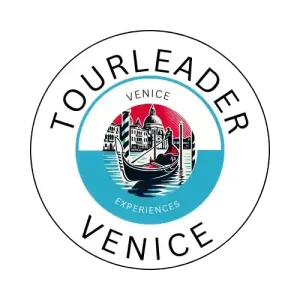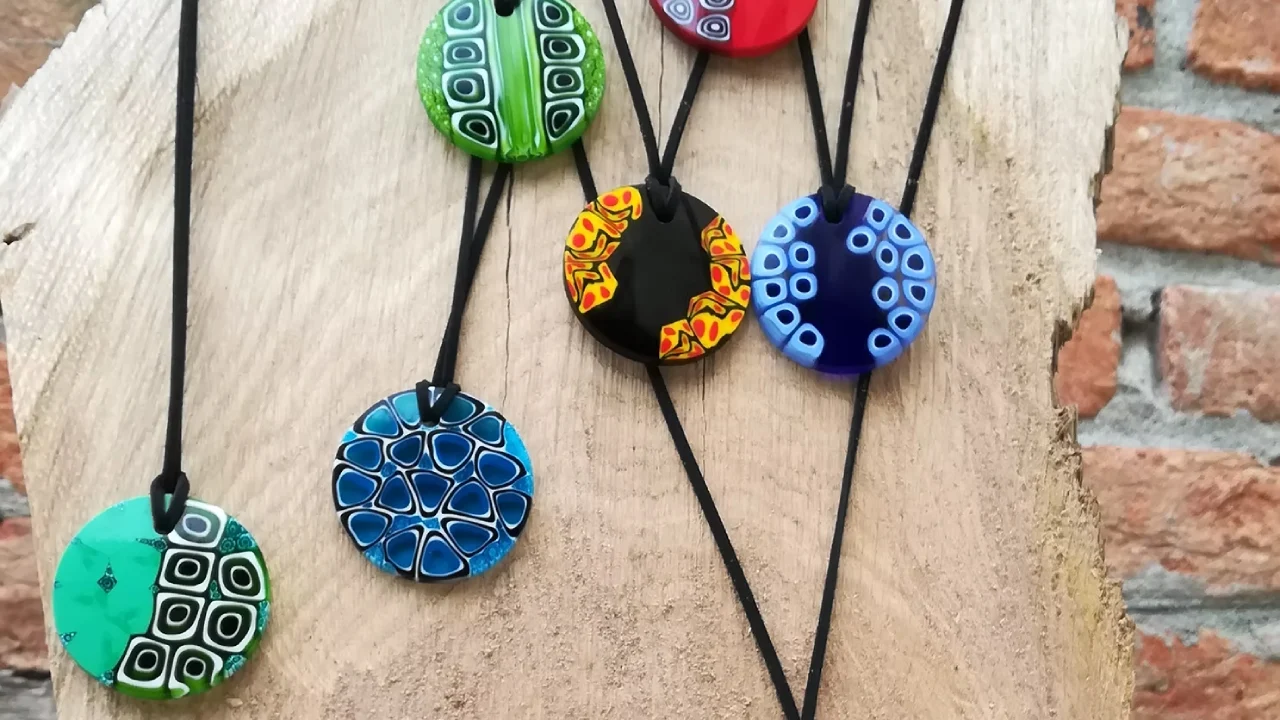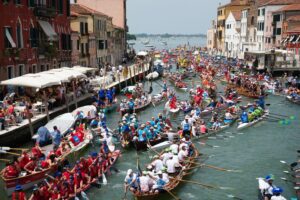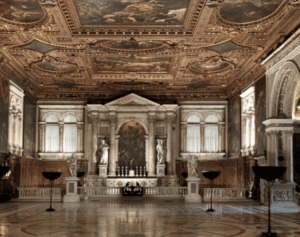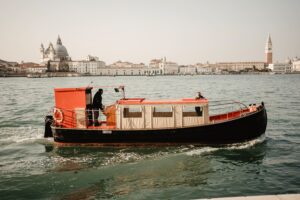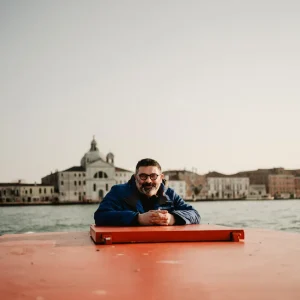The Story of Murano Glass — Venice’s Fiery Soul
In a world overflowing with mass-produced souvenirs, few things carry the same aura of authenticity as Murano glass. But what exactly is it? A brand? A technique? A place?
The answer, much like the glass itself, is layered — and luminous.
Murano glass is not a brand. It’s a tradition — a living art form born from fire and breath, shaped over 700 years of Venetian history. Each piece tells a story of devotion, patience, and mastery, crafted by artisans who transform grains of sand into shimmering works of art.
In this article, we’ll explore:
- The real history behind Murano glass — and why it began with fire
- Why it’s not a brand, but a protected cultural legacy
- The legend of Peter the Venetian — the man who defied the Republic
- How Murano glass helped create the Hall of Mirrors at Versailles
- How to tell real Murano glass from fake imitations
- And finally: how Tour Leader Venice can help you experience the real thing — up close, in the furnaces and studios of Murano itself.
So let’s step inside the fire — and into one of Venice’s most fascinating artistic legacies.
💎 What Is Murano Glass? (Hint: It’s Not a Brand)
Many travelers arrive in Venice assuming “Murano Glass” is a luxury brand — perhaps like Gucci or Versace. But in truth, it’s neither a company nor a trademark.
Instead, it’s a collective heritage — a centuries-old tradition that can only be carried forward by the glassblowers of Murano, a small island in the Venetian Lagoon just 1 km north of Venice. Every genuine piece of Murano glass is handmade on the island itself, using techniques passed down from master to apprentice since the Middle Ages.
It’s a bit like Champagne in France or Parmigiano Reggiano in Italy — the name refers to a place, a method, and a promise of authenticity. If it’s not made in Murano, it simply isn’t Murano glass.
And that’s what makes it so special: this is not industrial design. This is Venice’s living history — hot, fragile, and breathtakingly human.
🔥 A Long and Fiery History: The Origins of Murano Glass
The story of Venetian glass begins almost 2,000 years ago, when Romans experimented with molten silica. But it wasn’t until the 13th century that Venice — a powerful maritime republic — made a decision that would forever change its artistic destiny.
In 1291, the Venetian government issued an extraordinary decree: all glassmakers had to move their furnaces to the island of Murano.
The reason? Fire and secrecy.
- Fire risk: Venice was a city of wood, and glass furnaces burned at over 1,500°C. A single spark could devastate entire neighborhoods.
- Trade secrets: Venetian glassmaking was already world-renowned. By isolating artisans on Murano, the Republic protected its valuable techniques from spies and rivals.
Thus began a 700-year saga of innovation, artistry, and intrigue. Murano became both a creative laboratory and a gilded cage — a place where artisans worked with divine skill but were forbidden to leave without permission. Those who tried risked everything.
🏝️ Murano: The Island of Secrets, Sculptures, and Scalding Furnaces
Over the centuries, Murano glassmasters turned molten sand into miracles. Their furnaces produced objects that dazzled kings, popes, and emperors — chandeliers, goblets, beads, and mirrors so fine they were worth more than gold.
Among their most famous innovations:
- Cristallo: the first nearly colorless, transparent glass, perfected in the 15th century.
- Filigrana: delicate filigree designs of white glass threads within clear crystal.
- Aventurine: glass infused with copper crystals, creating a shimmering metallic sparkle.
- Millefiori: literally “a thousand flowers,” made by fusing cross-sections of colorful glass canes.
- Sommerso: layers of color suspended within clear glass, like pigment frozen in water.
Every piece was (and still is) born from collaboration — between heat, gravity, breath, and patience. To watch a Murano glassmaster at work is to witness alchemy in real time.
🕵️ The Legend of Peter the Venetian
Among the many stories that define Murano’s mythology, one stands out for its intrigue — the story of Peter the Venetian (Pietro il Veneziano).
In the 1600s, Venice’s glass secrets were so valuable that glassmakers were treated both as celebrities and as prisoners. They lived well — with privileges and high status — but if they left the island without permission, they risked death or exile.
Peter, a master glassmaker, is said to have done the unthinkable. He fled Murano, escaping the Republic’s spies, and brought his knowledge to France — directly into the court of King Louis XIV.
His act of defiance would spark one of the most famous architectural achievements in history.
💫 Murano Glass and the Hall of Mirrors at Versailles
When Louis XIV envisioned the Hall of Mirrors (Galerie des Glaces) for the Palace of Versailles, mirrors were among the rarest and most expensive objects on Earth. The only ones of comparable size and quality came from Murano.
To outshine Venice and prove France’s artistic dominance, Louis and his minister Jean-Baptiste Colbert secretly lured Venetian glassmakers — including, legend says, Peter the Venetian — to teach their techniques at the royal glassworks in Saint-Gobain.
The result? France learned to make large, flawless mirrors. Venice’s monopoly was broken — but Murano’s influence lived on in the 73-meter-long gallery that became a symbol of European splendor.
Even today, the mirrors of Versailles shimmer with the ghost of Venetian fire — a silent tribute to the island that taught the world how to reflect beauty itself.
🔍 How to Tell Real Murano Glass from Fake
Sadly, Murano’s fame has also made it a target for imitation. Every year, millions of “Murano-style” items — often made in China or Eastern Europe — are sold in Venice souvenir shops at bargain prices.
To protect yourself (and the craft), here’s how to identify genuine Murano glass:
✅ What to Look For
- Vetro Artistico® Murano sticker: the official certification by the Consorzio Promovetro.
- Certificate of authenticity: usually includes the artisan’s name and studio.
- Hand-engraved signature: reputable studios often mark each piece.
- Tiny imperfections: small air bubbles or asymmetries are a sign of hand craftsmanship, not flaws.
🚫 What to Avoid
- Cheap souvenirs sold far from Murano or with suspiciously low prices.
- Shops that don’t display a working furnace or active studio.
- “Murano-style” or “Murano-inspired” labels — these are not genuine.
When in doubt, trust your instincts — and your guide. At Tour Leader Venice, we work directly with certified Murano masters to ensure you experience the real thing, not tourist imitations.
🔥 Visit the Real Murano: Where Fire Still Lives
There’s only one way to truly understand Murano glass: see it in person. Step inside the furnace, feel the heat on your face, and watch glowing glass come alive under a master’s breath.
That’s why we’ve created authentic experiences designed to bring you closer to the heart of Murano’s craft.
👀 Watch Live Demonstrations
On our Murano Glass Workshop & Visit, you’ll stand just meters from the furnace as artisans create vases, chandeliers, and sculptures before your eyes. It’s mesmerizing — the hiss of molten glass, the rhythm of the blowpipe, the quiet concentration that turns chaos into grace.
🎨 Join a Hands-On Workshop
Prefer to create your own masterpiece? Try our Create Your Own Glass Bead Experience. Guided by a local maestro, you’ll melt, shape, and polish your own piece — a glowing souvenir that’s uniquely yours.
🏺 Explore Authentic Studios
We’ll take you behind the tourist façade, into real workshops like Vivarini — a family-run glass atelier near St. Mark’s that still crafts glasses and sculptures entirely by hand. These are not showrooms, but living spaces where art meets fire.
🏛️ Visit the Murano Glass Museum
Set inside the historic Palazzo Giustinian, the Murano Glass Museum showcases Venetian glass from antiquity to modern innovation. With our local guides, you’ll discover the hidden stories behind the pieces — including royal commissions and experimental designs.
🌅 Murano Beyond the Glass
Murano is more than furnaces and glassblowers. It’s a peaceful island where life moves to the rhythm of the lagoon — canals lined with flowers, fishermen chatting on the quays, church bells echoing over the rooftops.
During your visit, we’ll help you explore:
- The Church of Santa Maria e San Donato, famous for its Byzantine mosaics.
- Family-owned trattorie serving fresh seafood and local wine.
- Quiet artisan shops where you can meet the makers, not just buy their art.
Murano is the perfect escape from the crowds — and a reminder that the real Venice still exists, glowing quietly beyond the tourist trail.
💬 Why Choose Tour Leader Venice?
We’re not just guides — we’re locals. We live here, we collaborate with real artisans, and we believe in preserving Venice’s fragile culture by sharing it authentically.
When you explore Murano with us, you’ll get:
- ✅ Access to genuine workshops, not tourist traps
- ✅ Licensed local guides who speak fluent English
- ✅ Private or small-group tours — always personal, never rushed
- ✅ Flexible scheduling and private transfers by boat
- ✅ Honest advice, storytelling, and insider connections
This isn’t just sightseeing — it’s participation in a living legacy.
✨ Final Thoughts: Murano Glass Is Venice’s Fire-Formed Soul
So, what is Murano glass?
It’s not a brand — it’s a bond. Between fire and water. Between master and apprentice. Between Venice and the world.
Each piece carries centuries of invention, rebellion, and artistry. From the secret furnaces of the Middle Ages to the glittering mirrors of Versailles, Murano glass is a story of passion that refuses to cool.
And the best way to understand it?
Come to Murano. Stand near the furnace. Watch the glass take shape. Feel the heat, smell the smoke, and listen to the hum of creation.
Because when you witness Murano glass in its birthplace, you’re not just looking at art — you’re looking at Venice’s soul.
🔥 Book Your Authentic Murano Glass Experience
Travel deeper, discover real craftsmanship, and take home a piece of Venetian history with Tour Leader Venice.
FAQs About Murano Glass
Is Murano glass still made in Murano today?
Yes — every authentic piece of Murano glass is handmade on the island itself by certified artisans using centuries-old techniques. The furnaces still burn every day, and the craft continues through family-run studios that pass knowledge from master to apprentice.
How can I be sure my Murano glass is genuine?
Always look for the Vetro Artistico® Murano trademark sticker, issued by the Consorzio Promovetro. Genuine pieces may also include a certificate of authenticity and the artisan’s engraved signature. Be wary of “Murano-style” labels or prices that seem too good to be true — authentic craftsmanship is never mass-produced.
Can I visit a real Murano glass workshop?
Absolutely. You can watch live demonstrations or join hands-on classes at certified ateliers across the island. Experiences such as Murano Glass Workshop & Visit or Create Your Own Glass Bead Experience let you witness the fiery process up close — guided by local masters who keep this ancient Venetian art alive.
